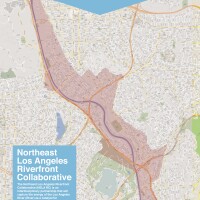Goal 1: Enhance a Sense of Place

Build a distinct identity and strengthen a sense of place within each local neighborhood.
Communal places, whether public or private, set the stage for our public lives. They are the parks where celebrations are held and children learn the skills of teamwork, the streets and sidewalks that connect places where friends and strangers run into each other, the businesses that create vibrancy and connectivity.
In Northeast LA, the River is a thread that swooshes past diverse neighborhoods. The NELA RC was driven by this goal to create a regional sense of place that is connected to the River, but builds off the five adjacent neighborhood identities and visions for improvement. Thus, the recommendations within this goal are aimed towards reinvigorating and strengthening urban spaces that reinforce a sense of place in each of the five neighborhoods and collectively as a riverfront district.
When communities have thriving communal places, residents have a strong sense of community, often created through the process of placemaking.
Placemaking is an inclusive and creative community process of developing a neighborhood's social, economic and cultural identity. The following objectives are guided by the distinct profiles of the neighborhood. The result of successful placemaking are feelings of pride and attachment, leading to greater involvement and sharing within communities. To a certain degree, placemaking is a principle that ties together all the goals of this plan.

Objectives
A. Create placemaking destinations that are local, but have a regional draw.
The inherently diverse nature of the Study Area presents many opportunities for each neighborhood to promote its own distinctive character that serves its residents while attracting visitors regionally. Currently, there are many multi- use hubs that are both local gems and regional gathering spaces, such as the L.A. River Center or the Rio de Los Angeles State Historic Park. As new projects arise, it will be important to ensure the needs of local stakeholders continue to be taken into consideration
B. Provide greater diversity in retail, food, and entertainment.
The NELA community is composed of numerous commercial nodes, with a diverse range of activity depending on the neighborhood. For example, Atwater Village is rich in its range of retail, food, and entertainment selection, while Elysian Valley has limited options. To enhance a sense of place, stakeholders requested a greater diversity in places to shop, eat, and play.

C. Create urban streetscapes that highlight neighborhoods and connect to the river.
Streetscape improvements, such as street medians or lighting, provide opportunities to showcase a neighborhood's identity. Neighborhood signage placed on key commercial corridors in Atwater Village and Glassell Park welcome residents and visitors alike. Placed on landscaped medians, these neighborhood markers provide both attractive urban streetscape and a marker of neighborhood identity. Similarly, green streets, such as Riverdale and Oros in Elysian Valley, provide charming pedestrian experiences to the Riverfront.
D. Promote cultural vibrancy through public art and special events.
Public places offer free, open, and diverse forums for people to encounter art
and participate in cultural activities with family, neighbors, or strangers. From
festivals in public plazas to community block parties on streets, the best public
spaces enhance cultural life by bringing people together. Public art or special
events can celebrate the identity of a neighborhood, like the Frogtown Artwalk
in Elysian Valley, or increase pride in a community assets such as the Friend of
the Los Angeles River' annual River Day cleanup.


